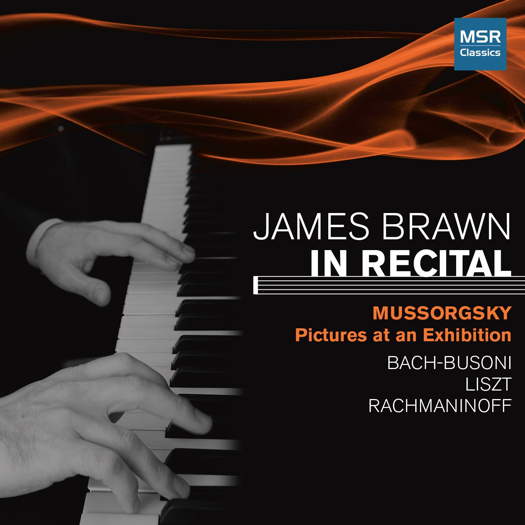 SPONSORED: CD Spotlight. True Command - James Brawn plays Bach, Liszt, Musorgsky and Rachmaninov - recommended by Andrew Schartmann.
SPONSORED: CD Spotlight. True Command - James Brawn plays Bach, Liszt, Musorgsky and Rachmaninov - recommended by Andrew Schartmann.
All sponsored features >>

Challenging in the Extreme
Symphonies by Brazilian composer Claudio Santoro, heard by GERALD FENECH
'... passionately and intensely executed by Neil Thomson and his Brazilian ensemble, the Goiás Philharmonic Orchestra.'
Claudio Santoro's fourteen symphonies represent the largest and most significant set of works in the genre ever composed in Brazil. Written between 1940 and 1989, they cover most of the composer's different aesthetic phases, and offer a comprehensive and detailed survey of the way in which his music evolved over the years. Santoro began his musical training in his native city of Manaus. An extremely talented violinist, he received a local government scholarship to continue his studies in Rio de Janeiro, and his earliest works date from this period.
His first symphony, written in 1940, when he was just twenty-one and had not yet begun to study composition in any formal way, impressed the German musician and teacher Hans-Joachim Koellreutter, leader of the 'Musica Viva' movement, made up of young composers seeking out new directions in which to take Brazilian music in line with the European avant-garde of the time. In the late 1940s however, Santoro's music took a radical turn as a result of his political-ideological convictions and his role as the Brazilian delegate to the 1948 Prague Congress of Progressive Composers, whose final manifesto urged composers to avoid excessive subjectivity and look to their national folk traditions for inspiration.
The works Santoro wrote during the 1950s were influenced by his search for a more direct and immediately communicative idiom, an effect he achieved by using national elements. During that decade, he composed four symphonies, of which the Fifth and Seventh were the most imposing in scale.
Listen — Santoro: Andante mosso - Allegro moderato (Symphony No 5)
(8.574402 track 1, 4:54-5:48) ℗ 2022 Naxos Rights (Europe) Ltd :
Santoro's Fifth Symphony was composed in 1955 and premiered the following year by the Rio de Janeiro Orquesta Sinfonica do Theatro Municipal, under the baton of the composer. Although this is one of the central works of Santoro's Brazilian phase and draws on folk-based material, his way of using this material is very different from the solutions employed by other composers of the period, in that he applies a more abstract approach, with no thought of reproducing traditional music or recreating the atmosphere of folk or other traditional forms.
Santoro's national decade was essentially rounded off by his Seventh Symphony, written in London in 1959 for a contest sponsored by Brazil's Ministry of Education and Culture to commemorate the completion of the construction of the country's new capital 'Brasília', officially inaugurated in April 1960. One of the longest and most complex of all Santoro's symphonies, this was also one of the composer's own favourite works and seems to point to the importance the city went on to have in his life in the decades to come.
Although it is not programmatic as such, the symphony does reflect with great intensity the historic moment at which it was composed, and, above all, the visions of modernity associated with the building of the new capital city. The Seventh Symphony was premiered in 1964 in Berlin, with Santoro himself at the helm of the Berlin Radio Symphony Orchestra. In the short space of time since its composition, however, as with the transitions between the previous decades – and as would also be the case with each of those to come before his death – Santoro had already gone through another turbulent period, experiencing a series of events that would have a profound impact on his music: the building of the Berlin Wall, the founding of the University of Brasilia, whose music department he established in 1962, and the military coup in Brazil in early 1964.
By that point, his music, as foreshadowed in the finale of the Seventh Symphony, was already heading in new directions. Indeed, for the rest of the decade up until his death in 1989 aged seventy, Santoro would be led into unchartered territory just like any other contemporary Brazilian composer. This is music by a restless and versatile composer who lived during a time of great changes, both in his country and in the world in general, so his compositions reflect all of this turmoil and his obsessive quest to be an artistic prophet of his day. This music is challenging in the extreme, but passionately and intensely executed by Neil Thomson and his Brazilian ensemble, the Goiás Philharmonic Orchestra.
Listen — Santoro: Allegro molto (Symphony No 7, Brasília)
(8.574402 track 8, 9:23-10:22) ℗ 2022 Naxos Rights (Europe) Ltd :
The good news is that this issue is the first volume of a projected cycle of all the Santoro Symphonies from the Naxos label. As in such previous undertakings, Naxos has always regaled us with invaluable collections that have enriched our knowledge of many a rare repertoire. I have no doubt that this 'Santoro' voyage will be a triumph as well.
Copyright © 5 April 2022
Gerald Fenech,
Gzira, Malta

CD INFORMATION - CLAUDIO SANTORO: SYMPHONIES 5 AND 7
CLASSICAL MUSIC ARTICLES ABOUT BRAZIL



